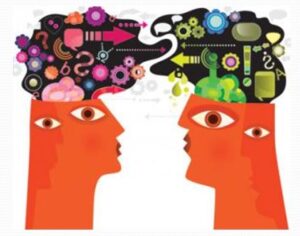Neuroscience shows our brains are wired for stories.
Let’s say you’re telling me about running a race. You’re at the starting line. Even though you’ve stretched, your leg muscles feel a little tense. You’re also a little tired, because you were too keyed up to get much sleep last night. The starting gun sounds — and you’re off! The field is crowded and you’re getting jostled by other runners. You’re focused on passing some of them so you can get a little more elbowroom and stretch your legs into a comfortable pace. You’re a bit nervous but hopeful that you’ll post a good time.
Two cool things are happening. First, the motor cortex in your brain is lighting up with electrical activity — as though you’re actually running the race. When you talk about your feelings, the emotional center of your brain lights up, too. Second, as I listen to your story, my motor cortex and emotional centers are lighting up — as though I’m running the race with you and sharing your feelings. Our brains are literally synchronized!
This is a much better way to build rapport than giving me a PowerPoint presentation or having me read a list of bullet points. When you do that, the only two areas of my brain that light up are the ones that recognize language. This means I’m listening with my dukes up and remain skeptical.
Why should you care? Because studies show that people accept ideas more readily when their brains are in story mode versus an analytical mindset.
How Stories Show We’re Full of Crap
Stories appeal to our emotions — and that’s the part of the brain where we actually make decisions. We like to believe we weigh the pros and cons and make a logical choice — guided by our cerebral cortex. But we’re just kidding ourselves.
We make decisions based on our emotions, and then we back and fill with logical arguments to justify our choices. How do we know? Studies have been done with people who have injured the part of their brain responsible for emotions. When asked something as simple as “do you want the red pen or the blue pen?” they can’t choose!
Now you understand how good stories create an emotional bridge between teller and listener. But too often we cheat our listeners by using stories as a sales technique. We describe the features of our products or services rather than talking about how they helped a particular client. We use words instead of images. We bludgeon people with what they should do rather than tell them why others have enjoyed the doing. And we leave listeners feeling disappointed rather than entertained and connected, which is the purpose of telling a story.

